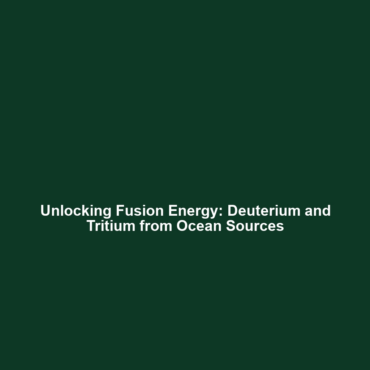Challenges in Fusion Energy: Ensuring Uniform Compression and Achieving Energy Breakeven
As the search for sustainable energy sources intensifies, fusion energy stands out due to its potential for providing vast amounts of clean energy. However, two significant challenges must be addressed: ensuring uniform compression and achieving energy breakeven. The ability to produce more energy from fusion reactions than is invested to initiate them is vital for making fusion a viable energy source. This article delves into these challenges within the broader context of fusion energy and highlights their significance.
Key Concepts
Understanding the challenges of uniform compression and energy breakeven is crucial in the pursuit of fusion energy. The following primary concepts are central to these challenges:
- Uniform Compression: Achieving uniform compression of fusion fuel, typically isotopes of hydrogen, is necessary to create the conditions required for nuclear fusion. This involves compressing the fuel to extreme temperatures and pressures, facilitating the fusion process.
- Energy Breakeven: Energy breakeven, or the point at which the energy output from a fusion reaction equals the energy input required to sustain it, is a critical milestone. To move towards a practical fusion reactor, systems must be designed to exceed this threshold.
- Plasma Physics: Understanding plasma behavior under various conditions is vital for addressing these challenges. Innovations in plasma confinement techniques directly impact the uniformity of compression and overall efficiency of the fusion process.
Applications and Real-World Uses
The challenges of ensuring uniform compression and achieving energy breakeven are pivotal for the real-world applications of fusion energy. Some significant applications include:
- Power Generation: If successful, fusion reactors can reliably produce electricity with minimal environmental impact, providing a sustainable alternative to fossil fuels.
- Space Exploration: Fusion propulsion systems offer the potential for faster travel through space, reducing the time needed for interplanetary missions.
- Medical Isotope Production: Harnessing fusion processes could facilitate the production of isotopes for medical applications, potentially revolutionizing diagnostic and therapeutic techniques.
Current Challenges
The following challenges highlight the limitations in studying and applying uniform compression and energy breakeven in the context of fusion energy:
- Difficulty in achieving and maintaining the required conditions for uniform compression of plasma.
- High energy inputs often outpace energy outputs, creating a gap in reaching breakeven.
- Technical and economic barriers in the development and deployment of fusion reactors.
- Limited understanding of instabilities in plasma that can disrupt fusion reactions.
Future Research and Innovations
Ongoing research aims to address the challenges of uniform compression and energy breakeven in fusion energy. Some notable innovations include:
- Advancements in magnetic confinement and inertial confinement techniques that enhance plasma stability.
- Development of next-generation fusion reactors, like the ITER project, intended to explore the viability of large-scale fusion energy production.
- Innovative materials for reactor components designed to withstand high temperatures and radiation.
Conclusion
In conclusion, ensuring uniform compression and achieving energy breakeven are critical hurdles in advancing fusion energy as a sustainable power source. Continued research and technological innovations are essential to overcome these challenges and uncover the true potential of fusion. For more insight into this topic, visit our pages on Fusion Research and Applications of Fusion Energy.









